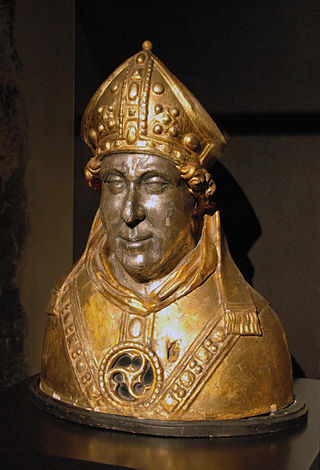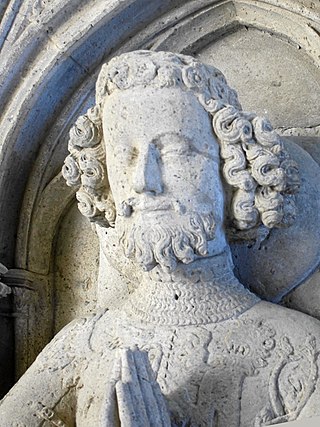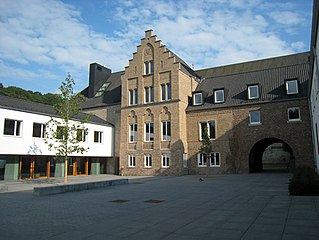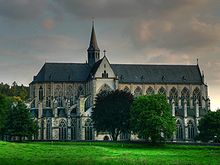
Berg was a state—originally a county, later a duchy—in the Rhineland of Germany. Its capital was Düsseldorf. It existed as a distinct political entity from the early 12th to the 19th centuries. It was a member state of the Holy Roman Empire.

The County of Mark was a county and state of the Holy Roman Empire in the Lower Rhenish–Westphalian Circle. It lay south of Lippe river on both sides of the Ruhr river along the Volme and Lenne rivers.
Isenberg was a County of medieval Germany. It was a partition of the county of Altena and was annexed to Limburg(Lenne) in 1242.

Count Engelbert II of Berg, also known as Saint Engelbert, Engelbert of Cologne, Engelbert I, Archbishop of Cologne or Engelbert I of Berg, Archbishop of Cologne was archbishop of Cologne and a saint; he was notoriously murdered by a member of his own family.

Burg Castle, located in Burg an der Wupper (Solingen), is the largest reconstructed castle in North Rhine-Westphalia, Germany and a popular tourist attraction. Its early history is closely connected to the rise of the Duchy of Berg.

William of Jülich-Cleves-Berge was a Duke of Jülich-Cleves-Berg (1539–1592). William was born in and died in Düsseldorf. He was the only son of John III, Duke of Jülich-Cleves-Berg, and Maria, Duchess of Jülich-Berg. William took over rule of his father's estates upon his death in 1539. Despite his mother having lived until 1543, William also became the Duke of Berg and Jülich and the Count of Ravensberg.
Adolf III of Berg was count of Berg from 1093 until 1132, and count of Hövel from 1090 until 1106, and Vogt of Werden. He was the son of Adolf II of Berg-Hövel, count of Berg, and Adelaide of Lauffen.
Altenberg is an Ortsteil (area) in the municipality of Odenthal in the Rheinisch-Bergischer Kreis of the State of North Rhine-Westphalia, Germany, and was formerly the seat of the Counts of Berg. Over the course of time, they created around their Residence a small dominion, which later came to be called the Bergisches Land.

William IV of Jülich-Berg was the last ruler of the Duchy of Jülich-Berg.
William II was born in Jülich, as the son of Gerhard VI of Jülich, Count of Berg and Ravensberg, and Margaret, daughter and heiress of Otto IV, Count of Ravensberg, and Margaret of Berg.

Gerhard VI of Jülich, Count of Berg and Ravensberg was the son of William V, Duke of Jülich and Joanna of Hainaut.
Henry of Berg, Lord of Windeck was the son of Adolf VII of Berg and Margaret of Hochstaden. He was the younger brother of Adolf VIII of Berg and William I of Berg.

Sibylle of Brandenburg was a Princess of Brandenburg by birth and by marriage Duchess of Jülich and Duchess of Berg. She was the governor-regent of Jülich-Berg for her daughter Maria from 1511 to 1524.
Otto IV, Count of Ravensberg was a German nobleman. He was the ruling Count of Ravensberg from 1306 until his death.

The Altenberger Dom is the former abbey church of Altenberg Abbey which was built from 1259 in Gothic style by Cistercians. Listed as a cultural heritage, it is located in Altenberg, now part of Odenthal in the Rheinisch-Bergischer Kreis, North Rhine-Westphalia, Germany. Until 1511, the church was the burial site of counts and dukes of Berg and the dukes of Jülich-Berg.

Haus Altenberg is a house for education and meetings of young people (Jugendbildungsstätte) of the Diocese of Cologne, located in Altenberg, now part of Odenthal, North Rhine-Westphalia, Germany. It was the centre of the Katholische Jugendbewegung in Germany from 1926 to 1954, interrupted only during World War II. Owned by the diocese, it is run by the association Jugendbildungsstätte Haus Altenberg.

Diederik III of Limburg Hohenlimburg, born around 1328, was the eldest son of Everhard II van Limburg Hohenlimburg and Juta of Sayn. Twenty years later he followed the 9th of August 1364 his grandfather Diederik II count of Limburg Hohenlimburg. In 1366 Diederik III became the Amtmann of Angermünde, the district between Duisburg and Düsseldorf. As the successor to lord Diederik III of Broich, who five years later would become his father-in-law. He also was Voght of the Rellinghausen Abbey. On 3 July 1371 Diederik married Ludgardis (Lukarda) daughter of Diederik of Broich and Katharina of Steinfurt. Lukarda was heiress of the Lordship Broich. At his wedding, he received a dowry of 1,600 old gold shields.

Dietrich IV of Limburg Hohenlimburg, born around 1375, was the second son Diederik III count of Limburg Hohenlimburg and Broich and Lukardis of Broich. He had an older sister Elisabeth and brother Willem I. Elisabeth married Dietrich IV of Volmestein. Willem married Metza of Reifferscheidt Erbin of Bedburg. Dietrich IV married Henrica of Wisch on 3 February 1415. Her father bannerlord Hendrik of Wisch and mother Elisabeth of Bronkhorst belonged to the most important nobility in Gelre. The bannerlords of Wisch had their castle Wisch on the old IJssel near Terborg.. Henrica had one younger sister Elisabeth married to Johan of Volmarstein. This created a double family ties between the Lower Rhine families Of Limburg, Of Volmarstein and the Gueldrian Of Wisch.

The brothers counts Willem II and Hendrik I, sons of Diederick IV count of Limburg Hohenlimburg Broich and Lukardis of Broich succeed each other as Count of Limburg Hohenlimburg Broich. In 1446, two years after the death of their father Diederick. The Archbishop of Cologne, after the conquest of Broich castle handed over his share of Broich to Willem II of Limburg. The Duke of Gullick-Berg also returned his share of Broich. Willem had to reconfirm provisions that his father Diederik IV had agreed upon in 1430. Brother Hendrik of Limburg continued to fight for the Cleves party. It was not until April 7, 1454, that he agreed to waiver of his Lordship rights to Broich.













